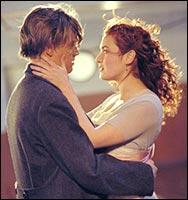Do films that win the Oscar for Best Picture cost more to make? The answer -- despite recent Oscars for mega-buck fantasies like The Lord of the Rings: Return of the King and Gladiator -- is a resounding no.
In fact, over the last 20 years, films that have walked off with the Best Picture statuette have cost only slightly more to make than a typical feature film.
Adjusted for inflation and excluding marketing expenses, the median budget for the last 20 Best Picture winners was $47.2 million, compared with a median budget of $41.7 million for a typical flick.
Why Do Oscar Winners Live Longer?
Powerful Actors, Never Nominated
 James Cameron's Titanic, which cost a whopping $280.4 million, was the most expensive winner, fully $217 million over 1997's average. Driving Miss Daisy was the cheapest -- its budget was $24.1 million below 1989's average of $36 million.* (Click here to see the budgets of the last 20 Best Picture winners as compared with industry averages.)
James Cameron's Titanic, which cost a whopping $280.4 million, was the most expensive winner, fully $217 million over 1997's average. Driving Miss Daisy was the cheapest -- its budget was $24.1 million below 1989's average of $36 million.* (Click here to see the budgets of the last 20 Best Picture winners as compared with industry averages.)
Of course, members of the Academy of Motion Picture Arts and Sciences don't look at a film's balance sheet before they cast their votes. But as Russ Leatherman, aka Mr. Moviephone, asserts, Hollywood "likes to reward smaller dramas rather than large blockbusters."
"Members of the Academy vote for what they like," says Dan Cohen, who co-produced with Bruce Jinks 1999's winner, American Beauty. "You can't fool them," says Saul Zaentz, producer of 1984's winner, Amadeus, and 1996's winner, The English Patient.
So what explains big-budget winners like Titanic, Gladiator and Lord of the Rings: The Return of the King? Theories vary. "When a film like Titanic or Lord of the Rings comes along that redefines what's possible in the realm of filmmaking, the Academy vote simply celebrates its accomplishments," says Cohen.
Leatherman has a different take. "The Academy is like everyone else," he says. "They try not to leave out something that everyone is talking about. They don't want to appear obsolete."
Smaller-budget films need savvy marketing strategies in order to attract attention. One of this year's Best Picture nominees, Sideways, received a groundswell of support from critics and hard-core film buffs soon after its release in October. That support was critical to putting it on the Academy's radar screen. 1989's winner, Driving Miss Daisy, followed a similar pattern. That film was initially released in a limited number of theaters, but as public awareness grew, additional venues were added.
"You hope to start with good reviews," says Entertainment Tonight film critic Leonard Maltin, "and then you can quote the reviews in your advertising."
Indeed, judicious advertising choices can make a big difference. American Beauty was given a big boost by a smart ad campaign from distributor DreamWorks SKG. The Walt Disney Co.'s (nyse: DIS - news - people ) Miramax division, in particular, has made an art out of combining smaller-budget productions with big-budget marketing. In fact, every year since The Crying Game was nominated in 1992, Miramax has scored at least one Best Picture nominee (The Aviator is its nominee this year).
These so-called "prestige pictures" can have much bigger returns than their big-budget companions. The English Patient, a Miramax co-production that cost just $46.7 million to make, grossed more than $230 million worldwide.
When asked about his financial strategies, Zaentz says with a sigh, "I don't look for inexpensive films. I look for something that moves me. And then I try to make it work financially."
*A previous version of this story incorrectly said American Beauty had the cheapest budget among the Best Picture winners.
| What Best Picture Winners Cost To Make | ||||
| Year | Winner For Best Picture Oscar | Budget ($mil)* | Average Budget ($mil)* | Percentage Difference |
| 1984 | Amadeus | $33 | $26.4 | 25% |
| 1985 | Out of Africa | $49 | $29.7 | 65% |
| 1986 | Platoon | $14 | $30.4 | -53.9% |
| 1987 | The Last Emperor | $38 | $33.7 | 12.8% |
| 1988 | Rain Man | $47 | $ 29.1 | 61.5% |
| 1989 | Driving Miss Daisy | $12 | $36.1 | -66.8% |
| 1990 | Dances With Wolves | $16.6 | $39 | -57.4% |
| 1991 | The Silence of the Lambs | $27.7 | $36.5 | -24.1% |
| 1992 | Unforgiven | $47.5 | $39.2 | 21.2% |
| 1993 | Schindler's List | $29 | $39.4 | -26.4% |
| 1994 | Forrest Gump | $68.2 | $44 | 55.0% |
| 1995 | Braveheart | $89.9 | $45.5 | 97.6% |
| 1996 | The English Patient | $46.7 | $48.3 | -3.3% |
| 1997 | Titanic | $280 | $63.3 | 342.3% |
| 1998 | Shakespeare in Love | $57.8 | $61.5 | -6% |
| 1999 | American Beauty | $20.1 | $58.8 | -65.8% |
| 2000 | Gladiator | $130 | $60.6 | 114.5% |
| 2001 | A Beautiful Mind | $64.5 | $51.3 | 25.7% |
| 2002 | Chicago | $47.6 | $62.2 | -23.5% |
| 2003 | The Lord of the Rings: The Return of the King | $97.2 | $ 66 | 47.3% |
| *2004 dollars, adjusted for inflation. Sources: Forbes, Baseline, MPAA, Box Office Mojo, Bureau of Labor Statistics | ||||







 © 2025
© 2025